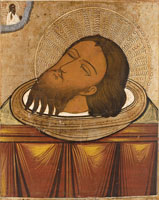The key figure linking Old and New Testaments, John was an itinerant Jewish preacher who purified his followers by bathing them in the River Jordan. He predicted the birth of Jesus. After some debate as to whether it should be the other way around, he also baptised Jesus; whereupon the Holy Spirit came down from Heaven, and a voice proclaimed Jesus the Son of God.
John then found himself in hot water when he condemned King Herod's marriage to his sister-in-law, Herodias. Perhaps because he feared John's popularity, Herod had him imprisoned, and he was eventually beheaded at Herodias' insistence.
When Jesus asked John to baptise him, the preacher was initially reluctant, saying that Jesus should be the one performing the rite on John. From the beginning, he recognised Jesus as the greater authority.
It was John who baptised Jesus and recognised him as the Messiah whose appearance was foretold by Old Testament prophets. As a preacher, he also attracted many followers in his own right.
Visitors to the Church of Saint Sylvester in Capite, Rome, can see the mummified head of John the Baptist in a glass case. So too can visitors to the Residenz Museum in Munich. Heads of John the Baptist have also been displayed in Istanbul, Egypt, France, Damascus and the village of Tenterden on the A28 in Kent. The head was, famously, removed from his body by King Herod, at the behest of Herod's wife Herodias and her daughter Salome.
John the Baptist is the earliest and most important of all saints. The practice of baptism that he undertook would become the standard mark of initiation into Christianity, while his life of self-imposed hardship in the desert would serve as a model for countless hermits and monks.














